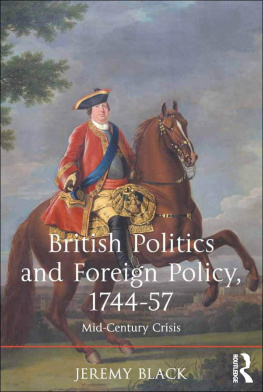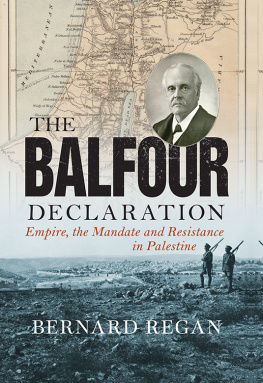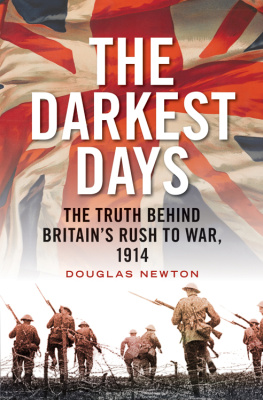Preface
Buildings can be deceptive. The British Foreign Office in Whitehall, London, is a case in point. Looking at it today, and knowing when it was built (in the 1860s), it is natural to assume that it was designed as it was in order to emphasize Britains great power in the world, now long passed. It is huge, heavy, dominating, vaguely Roman in its details, and topped off with statues of national heroes; all in all rather forbidding, even to new ministers David Miliband, foreign secretary from 2007 to 2010, admitted to finding it intimidating on his first visit; and so also, presumably, to most foreigners who have to pass through its doors and up its famously grand staircase. We know that it was Lord Palmerston, the great bully (allegedly) of British diplomatic history, who had it built, which must confirm this impression. Indeed, it seems so very obvious, simply from the appearance of the building, that few people have bothered to question this reading. It was built at the height of our Victorian imperial power, boasted a BBC television programme about the work of the Office in February 2010, specifically to impress foreigners, and in a style chosen to proclaim Britains status in the world. Of course it was. You only have to glance at it to see that.
But a glance is not enough. Examine the Foreign and Commonwealth Office (as it is now) more closely the stones, the style, the original designs, the discussions that took place over these, and the more general historical context behind the whole enterprise: more general, that is, than merely the height of our Victorian imperial power and a very different picture emerges. At the very least, it cannot be as simple as the impressing foreigners scenario; or, I would say, as dull.
For a start, let us look at the basic facts of the buildings origin. These are pretty well known to architectural historians, though not, I think, more generally. The circumstances were these. In 1855 the British government decided it needed some new Government Offices, to replace, in the first instance, the Foreign Office, which was (literally) falling about its ears, and the War Office, which was inconveniently scattered all over London. (This was in the middle of a war.) So it held a competition, to help it pick a design. The outcome of that was messy; but the architect eventually chosen from among the winners was George Gilbert Scott, well known at the time as a Gothicist that is, one who sought to revive mediaeval principles of building who had produced a Gothic plan. So it looked as though the new Offices would be in that style. Before this could happen, however, there was a change of government, and the aged Lord Palmerston became prime minister. Palmerston loathed Gothic. He could not get rid of Scott, who had already been promised the job; but he insisted he redesign the building in the Classical style. Scott protested, but eventually caved in, to the disappointment to put it mildly of his fellow Gothicists. That was in 1861. (The row was known at the time, and is referred to in all the architectural histories of this period, as the Battle of the Styles.) The result is the building that still stands in Whitehall today, housing not only the Foreign and Commonwealth Office but also the Home Office, and various other departments of state. If it had gone the other way we would have had something like the present very Gothicky St Pancras Station Hotel, also by Scott and his riposte to the critics of his original Foreign Office designs. Opinions differ over whether that was a lost opportunity or a lucky escape.
It is an entertaining tale, more so than the histories of most architectural projects, though there are parallels. The controversy in the 1870s over the style of the new German Reichstag was one, in that case also won by the Classicists; The most recent was probably the public row in 2009 between Lord Rogers and Prince Charles over the redevelopment of Chelsea Barracks, with Rogers being the Scott of his day, and Charles the Palmerston, and the ultimate victor there. (A case will be made out here for Gothics being the modern style in the 1850s.) In the case of the Government Offices the row was enlivened by various skullduggeries, hints of scandal, low farce, some quite good jokes mainly from Palmerston, who used them to win over support in the House of Commons and ungentlemanly language all round. The smell of ordure rising from the Thames also played a part. It was a lively affair, worth telling, perhaps, for that reason alone. (I shall be telling it, straight, in Chapter 1.)
But all this must detract from the significance of the building itself, in the form it ultimately took, if we want to infer from it something important about the character of Britain at this time. Its style was something of an accident. It could very easily have gone another way. Would a St Pancras Hotel in Whitehall have given off the same aura of imperial power and domination that Scotts final design is said to do? (That may be a matter of opinion. We shall be coming back to it.) In any case almost no one at the time said that British power and domination, or empire, or prestige, or whatever, was what they wanted the building to express. (Of course it might have gone without saying; but I think I can show not.) A significant number of MPs wanted no new building at all foreign secretaries, they said, should use their own town houses for conducting their business and a much larger number would have preferred the Foreign Office to be much more modest in scale than it turned out. The foreign secretary of the day who was not Palmerston, as it happens, but Lord John Russell (Palmerston was prime minister) had not cared what it looked like so long as it had a roof on to keep his clerks and secretaries dry. His permanent secretary the top Foreign Office mandarin, that is felt it was far too grand both for his liking and for its purpose. Most of the press of the time thought so too. Palmerston, though he was largely responsible for the way it came to look, never really liked it. The best he could say of it was that it would do. Even its architect, Scott, virtually disowned it. Scarcely anyone beyond ministers and civil servants and precious few of those had taken any interest at all in the building while it was being planned and constructed, and those who had did so for a variety of reasons, very few of which had anything to do with the expression of British power. It was not a popular building at the time, and has never attracted much attention subsequently: from foreign and provincial tourists in London, for example, who are mostly oblivious of it as they pass it on their way from Westminster (to see the abbey and the Houses of Parliament, which are much loved), to Trafalgar Square (to feed the pigeons). All this must mean that we should be wary, at least, before attempting to read anything important into or even between the lines of the present Foreign Office building alone.
The Battle, however, was something else. That was important, in two ways. The first is in an architectural historical context; where it is supposed, at any rate, to have marked a crucial stage in a wider war that had been going on for the previous 20-odd years between the advocates of the Gothic and Classical styles, for the architectural soul of England, no less. By the 1850s this had established Gothic as the dominant style for churches, colleges and, in its Jacobethan form, for country mansions, but not yet for large urban secular public buildings (despite the new Perpendicular Palace of Westminster; or even because of it). That was the new field the Goths were looking to conquer. The Government Offices, because of their size and importance, were the fortress they needed to topple in order to be able to march on. Both Scott and Palmerston saw it in these terms: Scott as a way of conclusively proving that his Gothic style was suited to every kind of building; Palmerston more apprehensively as the thin end of a wedge that would Gothicize the whole of London if Scott won. So a lot was thought to depend on the outcome. Whether that outcome was as crucial as the contemporary battlers thought is questionable. It was undoubtedly a setback for the Goths, but not necessarily an irreversible one. There are several great public buildings still standing from after 1861 that were built in Gothic (or Gothic- ish ); including, for example, the new Law Courts in London, much of the South Kensington museum complex, and Manchester Town Hall. (In much the same way, it seems unlikely that Prince Charless blow to modern architecture in the Chelsea Barracks affair will be a fatal one.) But Scotts defeat, or apostasy, certainly had some effect. We shall be discussing this the aftermath of the Battle in the final chapter of this book.










